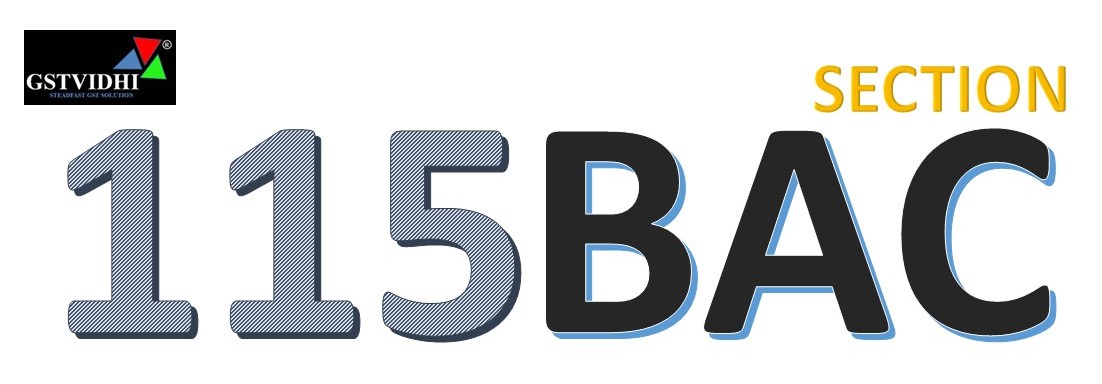
New Regime under Section 115BAC and Rebate under Section 87A
(A.Y. 2025–26 & A.Y. 2026–27)
The Indian Income-tax
Act, 1961 introduced a concessional tax regime under Section 115BAC,
popularly known as the new regime, to simplify taxation by offering
lower rates but restricting exemptions and deductions. To make the regime
attractive for middle-class taxpayers, the government has gradually enhanced
the basic exemption and rebate thresholds through recent Finance Acts.
Tax Slabs
under the New Regime
For Assessment Year
2025–26 (Financial Year 2024–25), the slabs are as follows:
- Up to ₹3,00,000 – Nil
- ₹3,00,001 to ₹7,00,000 – 5% of income
exceeding ₹3,00,000
- ₹7,00,001 to ₹10,00,000 – ₹20,000 +
10% of income exceeding ₹7,00,000
- ₹10,00,001 to ₹12,00,000 – ₹50,000 +
15% of income exceeding ₹10,00,000
- ₹12,00,001 to ₹15,00,000 – ₹90,000 +
20% of income exceeding ₹12,00,000
- ₹15,00,001 to ₹50,00,000 – ₹1,50,000
+ 30% of income exceeding ₹15,00,000
- Above ₹50,00,000 – Tax at 30% with
applicable surcharge and cess
From Assessment Year
2026–27 (Financial Year 2025–26) onwards, the government has rationalized
slabs and increased the exemption threshold to ease the tax burden. The revised
slabs are:
- Up to ₹4,00,000 – Nil
- ₹4,00,001 to ₹8,00,000 – 5% of income
exceeding ₹4,00,000
- ₹8,00,001 to ₹12,00,000 – ₹20,000 +
10% of income exceeding ₹8,00,000
- ₹12,00,001 to ₹16,00,000 – ₹60,000 +
15% of income exceeding ₹12,00,000
- ₹16,00,001 to ₹20,00,000 – ₹1,20,000
+ 20% of income exceeding ₹16,00,000
- ₹20,00,001 to ₹50,00,000 – ₹2,00,000
+ 30% of income exceeding ₹20,00,000
- Above ₹50,00,000 – Tax at 30% with
applicable surcharge and cess
This shift, especially
the higher exemption of ₹4 lakh and broader slabs, benefits lower and
middle-income groups substantially.
Rebate
under Section 87A
The rebate under Section
87A plays a crucial role in providing full tax relief to small taxpayers.
The provision has undergone multiple amendments over the years, and its
applicability now depends on both the assessment year and the chosen
tax regime.
For earlier years, the
rebate was available to residents with income up to ₹5,00,000, with a maximum
deduction of ₹12,500. However, from A.Y. 2024–25 onwards, the rebate
threshold under the new regime was increased to ₹7,00,000,
ensuring that individuals opting for Section 115BAC and earning up to this
level pay no tax.
The Finance Act, 2025
has further enhanced this relief. Effective from A.Y. 2026–27, a
resident individual opting for the new regime and having a total income of up
to ₹12,00,000 will be eligible for rebate under Section 87A. The rebate
amount is equal to 100% of the income-tax payable or ₹60,000,
whichever is lower. In case the income slightly exceeds ₹12,00,000 (as per
special marginal relief conditions), the rebate is adjusted to ensure that the
tax payable does not exceed the amount by which income crosses the threshold.
Thus, an individual with
an income up to ₹12 lakh under the new regime will continue to enjoy a “zero
tax liability” from A.Y. 2026–27.
Essential
Conditions for Claiming Rebate
The rebate under Section
87A is available only to:
- An individual who is a resident in
India.
- The benefit is computed on total
income after deductions, not on gross income.
- Rebate is applied before health
and education cess.
- Negative income from house property,
such as self-occupied home loan interest, is adjusted before determining
eligibility.
- Filing of income-tax return is mandatory
even if the rebate reduces liability to nil.
Interaction
with Form 10-IEA and Employer Declarations
Taxpayers who wish to
continue under the old regime must submit Form 10-IEA online
before the due date under Section 139(1). Salaried individuals can change their
choice every year, while taxpayers with business income can switch only once.
For employees, an
intimation must be given to the employer at the start of the financial year so
that TDS is deducted under the chosen regime. Nevertheless, the final selection
can still be made while filing the return.
Conclusion
The reforms effective
from A.Y. 2026–27 mark a significant relief for middle-income earners,
as the rebate limit under Section 87A rises from ₹7,00,000 to ₹12,00,000
and the exemption threshold is lifted to ₹4,00,000. This ensures that
individuals earning up to ₹12 lakh in the new regime will face no income-tax
liability. The widening of slabs also reduces the tax incidence for those
earning slightly above this limit.
While the new regime is
gradually becoming the default choice, individuals with substantial exemptions
such as HRA, home loan benefits, or large Section 80C investments may still
find the old regime advantageous. Hence, taxpayers must evaluate both regimes
each year before finalizing their return.
Disclaimer: All the Information is based on the notification, circular advisory and order issued by the Govt. authority and judgement delivered by the court or the authority information is strictly for educational purposes and on the basis of our best understanding of laws & not binding on anyone.
Press On Click Here To Download Order File
Click here